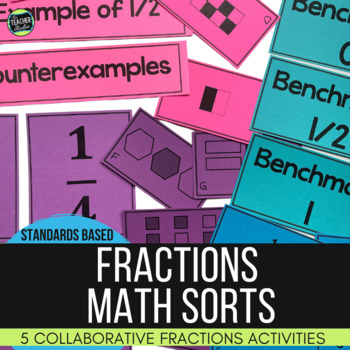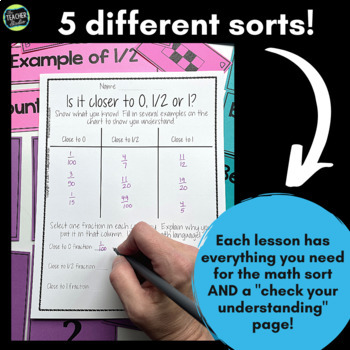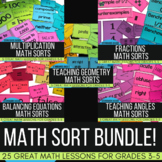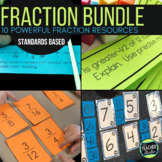5 Fractions Math Sorts - Comparing Fractions - Equivalent Fractions - And More!
- PDF
What educators are saying
Also included in
- Are you familiar with math sorts? Are you interested in helping your students address math misconceptions, develop their deep math understanding and grow their "math talk"? These ready-to-print, low ink lessons are perfect to reach all the math practice standards! New to math sorts? Full directPrice $24.95Original Price $32.50Save $7.55
- TEN of my top-selling fraction resources to help you teach your fraction lessons and help your students truly develop their deep understanding of fractions are now bundled for you!After multiple requests, I have bundled together these 10 fraction activities to provide truly everything you will needPrice $35.00Original Price $48.70Save $13.70
Description
Teaching fractions can be one of the most challenging math topics to teach--and textbooks rarely get at the deep thinking needed to help students master basic fraction skills--much less more complex fraction concepts such as equivalent fractions, comparing fractions, or estimating with benchmark fractions.
No worries! I’ve got your back! I not only love teaching fractions, but I have spent years working to create fraction activities and lessons that are engaging, low prep, and highly successful. Read on!
This math sort resource is a low-ink, ready-to-print set of quality fraction activities with full-color pictures and directions!
So what are math concept sorts? Many people use "sorts" with their spelling or word work programs, but sorting and categorizing can be extremely effective learning strategies for MANY areas! I have found sorts to be particularly effective in my math instruction, and I am excited to offer some of these sorts to you!
If you are unfamiliar with how sorts are used, I have included a full blog post with photos to help get you started! So...what's included in THIS edition?
*Everything you need to do 5 different sorts with fractions. The concepts covered are:
1. “Is it exactly 1/2?” (understanding of equal parts)
2. “Estimating: Is it closer to 0, 1/2, or 1?” (using benchmarks to estimate)
3. “Is it <, >, or = to 1/2?” (working with greater than, less than, and equivalence)
4. “Does it add/subtract to equal 1?” (addition and subtraction of fractions)
5. “Fractions of sets” (finding equivalent fractions of sets rather than regions)
WHAT ELSE IS INCLUDED?
- The blog post with photos that explains EXACTLY how I completed a sort with my own students. Feel free to get creative and try different approaches—but I have given one highly effective and efficient way to do this.
- A “Show What You Know” sheet that follows the rule of the sort. Use as independent practice or as an assessment after you have done a sort to see what the students know and what they still need to learn. Many of these also ask students to explain their thinking—a key part of the CCSS!
- A page of blank cards if you wish to extend the learning by having students create MORE examples that go in each category. This is a great way to differentiate for more capable learners! See each sort for other differentiation hints!
- No answer key. Why? The important part about doing these sorts is the discussion rather than making sure every answer is instantly correct. Let the students discuss, prove their ideas, and develop understanding!
- A CCSS alignment sheet to show how these sorts align to the grades 4-5 CCSS.
I hope you find the resource thorough, relevant, and engaging--and that it will push your students to increase the depth of their understanding and their mathematical practices as well.
Please check out the preview to see more!
------------------------------------------------------------------------------------
What sets of concept sorts are available in my store?
------------------------------------------------------------------------------------
Need other fraction resources? Check out this amazing FRACTION BUNDLE!
------------------------------------------------------------------------------------
All rights reserved by ©The Teacher Studio. Purchase of this resource entitles the purchaser the right to reproduce the pages in limited quantities for single classroom use only. Duplication for an entire school, an entire school system, or commercial purposes is strictly forbidden without written permission from the author at fourthgradestudio@gmail.com. Additional licenses are available at a reduced price.







